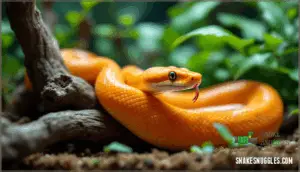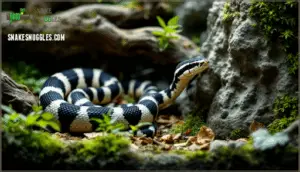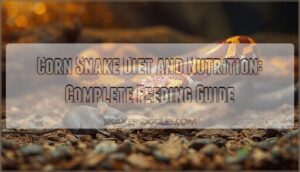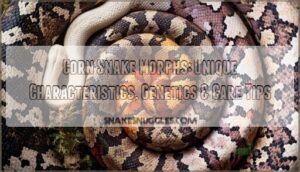This site is supported by our readers. We may earn a commission, at no cost to you, if you purchase through links.
 Owning a snake isn’t what most people expect. There’s no begging for walks at 6 AM, no shedding on furniture, and no vet bills every time your pet sneezes. These reptiles thrive on benign neglect—a feeding every week or two, a clean enclosure, and stable temperatures.
Owning a snake isn’t what most people expect. There’s no begging for walks at 6 AM, no shedding on furniture, and no vet bills every time your pet sneezes. These reptiles thrive on benign neglect—a feeding every week or two, a clean enclosure, and stable temperatures.
That simplicity attracts people with allergies, busy schedules, or anyone tired of high-maintenance companions. But "low-maintenance" doesn’t mean "one-size-fits-all." A docile corn snake and a seven-foot boa constrictor demand vastly different commitments.
Choosing the right species means matching temperament, adult size, and care complexity to your experience level and living situation.
Table Of Contents
Key Takeaways
- Choosing the right snake means matching temperament, adult size, and care needs to your experience level and lifestyle.
- Snakes are low-maintenance, hypoallergenic pets, but responsible ownership requires understanding species-specific habits, health risks, and long lifespans.
- Captive-bred snakes offer healthier, more manageable pets and support wildlife conservation by reducing pressure on wild populations.
- Market growth and social media trends are boosting snake ownership, making it crucial to prioritize ethical sourcing, proper care, and animal welfare.
Benefits of Snake Ownership
Snakes offer distinct advantages that appeal to many reptile enthusiasts. They don’t require daily walks, won’t trigger your allergies, and thrive with minimal intervention compared to most pets.
Let’s examine the practical benefits that make these animals worth considering for your home.
Low-Maintenance and Hypoallergenic Qualities
If you’re drawn to the idea of a pet that won’t trigger your allergies or demand constant attention, snakes offer a surprisingly practical choice that defies the high-maintenance stereotype of most companion animals. Unlike mammals with dander, pet snakes are hypoallergenic and require minimal daily care—no feeding schedules to juggle multiple times a day.
Beginner-friendly species like corn snakes and ball pythons thrive in quiet environments with proper snake care, though you’ll want to balance interaction considerations with their need for solitude.
Lifespan and Long-Term Commitment
Owning a snake isn’t a decision you make on a whim—these animals can share your home for 15 to 30 years depending on the species, demanding a commitment that outlasts most college degrees and car loans.
Species longevity varies widely: ball pythons often reach 30 years, while garter snakes usually live 8–10 years.
Genetic factors, healthcare costs, and end-of-life care all fall under owner responsibility, making responsible pet ownership essential before bringing any snake home.
Behavioral Traits and Interaction
Snakes don’t greet you at the door or curl up in your lap, but they do recognize routine, tolerate interaction when done correctly, and can even show curiosity toward their keepers over time. Understanding snake behavior and biology helps you interpret their actions—like flicking tongues to "taste" their environment or retreating when stressed. Species temperament varies: ball pythons tend toward docility, while king snakes display more curiosity. Recognizing stress signals guarantees safer snake interaction and better captive behavior outcomes.
Key behavioral observations:
- Snakes lack emotional bonding but become familiar with consistent routines
- Environmental enrichment (hides, branches) reduces stress and promotes natural behavior
- Over-interaction causes stress; limit sessions to 10–15 minutes several times weekly
- Different snake species exhibit distinct activity levels and temperaments
- Reading body language—tensing, hissing, or balling up—prevents bites and improves welfare
Suitability for Allergy Sufferers
For allergy-prone households, snakes offer a practical advantage—they produce no dander, shed infrequently, and don’t trigger the respiratory issues common with furred or feathered pets.
Snake allergens are virtually nonexistent compared to traditional animal companions.
Basic care precautions and routine enclosure hygiene further support allergy mitigation, making exotic pet ownership accessible where conventional animal care might pose health risks.
Key Factors in Choosing a Pet Snake
Choosing the right snake isn’t just about picking the prettiest one at the pet store. You’ll need to weigh several factors—temperament, adult size, availability, and even local laws—before bringing one home.
Let’s walk through the key considerations that’ll help you make an informed choice.
Temperament and Handling Needs
Your snake’s temperament—whether it’s a calm coil of composure or a wriggling bundle of nerves—will dictate how often you can interact with it, how predictable your interactions become, and whether you’ll spend your evenings relaxed or second-guessing every movement.
Consider these interaction factors before choosing a species:
- Interaction frequency: Beginner-friendly species tolerate weekly sessions; nervous snakes need minimal contact to reduce stress signs.
- Snake personality: Ball pythons exhibit calm, predictable snake behavior; king snakes show curiosity but may be defensive.
- Bite risk: Understanding animal behavior helps you read body language and avoid strikes during snake care.
- Secure interaction: Proper technique protects both you and your snake, making snake ownership rewarding rather than anxious.
Size and Growth Expectations
Before you commit to a hatchling corn snake or a juvenile ball python, you need to grasp the full scale of what that animal will become—both in length and in the demands it places on your space, budget, and daily routine.
Adult size varies dramatically across popular species: corn snakes usually reach four to five feet, while boa constrictors can exceed ten feet, requiring substantially larger enclosure size, more frequent shedding cycles, and escalating dietary needs as growth rate accelerates through their first few years of life.
Captive-Bred Vs. Wild-Caught Snakes
When choosing between captive-bred snakes and wild-caught snakes, ethical sourcing and health differences matter enormously. Captive-bred snakes adapt more readily to interaction, carry fewer parasites, and support conservation impact by reducing pressure on wild populations.
Wild-caught snakes face acclimation challenges, harbor more pathogens, and exhibit behavioral adaptations that make snake care harder for any responsible snake keeper prioritizing animal welfare and successful snake ownership.
Captive breeding guarantees healthier animals for pet owners.
Legal and Ethical Considerations
Ownership restrictions vary widely across jurisdictions—at least 15 U.S. states ban or limit large or venomous species, while Taiwan’s October 2025 regulations prohibit all vipers and cobras with steep fines. As a responsible snake keeper, you must:
- Verify local and state laws before acquiring any species, as permits may be required and native species are often restricted
- Choose captive-bred snakes to combat illegal trade, which threatens up to 20% of wild populations annually in Southeast Asia
- Commit to lifelong care to prevent surrender—45% of relinquished snakes are abandoned within two years due to underestimated needs
Snakes require specific habitats, so consider their environmental and care requirements before acquiring one.
Public safety, animal welfare, and wildlife conservation intersect in these regulations. Ethical debates continue around captivity’s impact on sentience and natural behaviors, making informed, welfare-focused decisions essential for animal welfare and ethics in wildlife management.
Beginner-Friendly Snake Species Guide
If you’re ready to bring a snake into your life, starting with the right species makes all the difference. The options below offer manageable care requirements and forgiving temperaments that work well for first-time owners.
Let’s look at four species that consistently prove themselves as reliable companions for beginners.
Corn Snakes: Docile and Manageable
If you’re searching for a snake that won’t throw curveballs at you during interaction, corn snakes are about as predictable and forgiving as they come. These beginner-friendly species tolerate regular interaction without stress, adapt well to standard enclosure sizes, and thrive on straightforward feeding habits—frozen-thawed mice every 5–7 days.
Their docile temperament and stunning morphs make them ideal starter pet snakes for any new snake owner.
Ball Pythons: Calm and Popular
Ball pythons reign as America’s favorite pet snake—accounting for over 30% of all U.S. snake ownership—largely because they’re about as close as you’ll get to a low-stress, handleable reptile that won’t test your patience or your nerves. Their calm temperament and manageable size make ball python care straightforward for beginners:
- Morph variations offer stunning pattern diversity—from piebald to banana
- Enclosure enrichment needs are minimal: secure hide, water bowl, heat gradient
- Temperament issues rarely surface with proper interaction schedules
- Common illnesses like respiratory infections are preventable with correct humidity
- Breeding challenges exist but remain accessible to intermediate keepers
These beginner tips make species profiles for pet snakes almost always start here.
Garter Snakes: Active and Friendly
While ball pythons may be the laid-back crowd-pleasers, garter snakes bring an entirely different energy to the table—one that’s all about movement, curiosity, and a surprising willingness to engage with their keepers. These active pet snakes thrive on habitat enrichment and feeding variety, requiring more involved care than sedentary species.
Living 8–10 years in captivity, garter morphs range from striped classics to vibrant checkered patterns. Beginner tips: respect their speed during interaction techniques and accommodate their brumation needs for best wellness in your snake species selection.
| Care Element | Garter Snake Requirements |
|---|---|
| Diet | Fish, worms, insects—rotate for health |
| Activity Level | High; provide climbing, exploration space |
| Brumation | Optional cooling period (50–60°F) |
| Handling | Frequent, gentle sessions build trust |
King and Milk Snakes: Curious Companions
King and milk snakes bring a different flavor of engagement—these are the curious investigators of the snake world, actively exploring their surroundings with a boldness that sets them apart from their more reserved cousins. Together accounting for roughly 15% of pet snake ownership, these species identification standouts offer temperament variations worth understanding:
- Enclosure enrichment: Provide multiple hides, branches, and textured surfaces to satisfy their exploratory drive
- Diet diversity: Rodent-based meals delivered with proper care techniques prevent feeding aggression
- King snake care: Monitor closely—known ophiophagous tendencies mean separate housing is non-negotiable
- Snake keeping reality: Moderate experience helps, though their manageable size suits committed beginners
Advanced and Intermediate Snake Species
Once you’ve mastered beginner species, you might be ready to move up. Intermediate and expert snakes demand more space, specialized care, and a deeper commitment to their long-term needs.
Here’s what you should know before taking that step.
Boa Constrictors: Large and Demanding
Boa constrictors aren’t your starter snake—these are the heavyweights that demand serious space, consistent care, and a keeper ready to work with an animal that can stretch past ten feet and live three decades.
Temperament variations run the gamut from docile to defensive, so care techniques matter. You’ll need a durable enclosure—think six feet minimum for adults—with secure locks and proper temperature gradients.
Feeding challenges escalate as boas mature, changing from mice to rabbits, and their sheer size makes every aspect of snake care more labor-intensive.
Carpet Pythons: Care and Space Needs
Carpet pythons share that large-bodied reputation but bring an arboreal twist—they’re climbers who need vertical space and a setup that accounts for both their length and their love of perching.
- Enclosure size should be six feet minimum with height for climbing branches and enrichment ideas like cork bark perches
- Temperature and humidity control requires basking spots around 88°F with heating needs met through ceramic emitters, plus humidity levels near 60%
- Temperament variations lean defensive in juveniles—consistent interaction improves trust, though snake care demands respect for their speed and strength
Species Requiring Specialized Diets
Beyond rodents, some exotic pet species demand serious homework. Egg-eating snakes swallow bird eggs exclusively—juveniles need finch eggs, while adults manage chicken-sized options. Insectivorous snakes like rough green snakes require diverse insects for proper reptile nutrition. Aquatic diets suit garter snakes, but you’ll need thiaminase-free fish and supplements to prevent deficiencies. Earthworm specialists feed more frequently due to the lower energy content per meal.
| Snake Species | Primary Diet | Feeding Schedules & Notes |
|---|---|---|
| Egg-eating snakes (Dasypeltis) | Bird eggs only | Finch eggs for juveniles; chicken eggs for adults; nocturnal hunters |
| Rough green snakes | Crickets, caterpillars, moths | Daily or every other day; high malnutrition risk if variety lacking |
| Garter snakes (aquatic) | Fish, amphibians, earthworms | Thiaminase-free fish required; supplement non-rodent diets |
| Rhabdophis (toxin sequestration) | Firefly larvae | Extremely specialized; obtains defensive toxins from prey |
| Earthworm specialists | Earthworms exclusively | Frequent feedings due to high water content in prey |
Longevity and Advanced Care Challenges
Committing to a long-lived species means managing decades of husbandry expertise, not just years of trial and error. Extended lifespans in boas and pythons—often 25–30 years—demand evolving reptile health vigilance:
- Geriatric care for aging snakes includes joint support and modified heating
- Health monitoring through regular veterinary care catches metabolic bone disease early
- Complex diets require adjusting prey size as metabolism slows
- Enrichment needs prevent boredom-related behaviors over decades
- Snake behavior and psychology shifts with age, requiring owner adaptation
Long-term snake owner advice: anticipate changing care requirements as your companion matures.
Essential Care, Habitat, and Nutrition
Getting the basics right matters more than you might think. Your snake’s health depends on a proper enclosure, consistent temperatures, and the right feeding routine.
Let’s walk through what you need to set up and maintain a healthy environment.
Enclosure Setup and Security
Your snake’s enclosure isn’t just a container—it’s the foundation of their health. If it’s not secure, you’ll quickly discover how talented snakes are at becoming escape artists. Start with a glass or PVC terrarium featuring escape-proof lids with locking mechanisms.
Substrate options like aspen shavings or coconut fiber provide comfort, while heating systems and enrichment items—hides, branches, climbing structures—create a functional habitat design and setup that fosters natural behaviors.
| Component | Purpose | Example Options |
|---|---|---|
| Enclosure Base | Secure housing with escape prevention | Glass terrarium, PVC cage |
| Substrate | Comfort and hygiene | Aspen shavings, coconut fiber |
| Heating Systems | Temperature control and thermoregulation | Heat mats, ceramic emitters |
| Hides & Enrichment | Security and behavioral stimulation | Cork bark, artificial caves |
| Locks & Lids | Preventing escapes | Clamp locks, sliding screen tops |
Temperature and Humidity Control
If a snake’s temperature or humidity swings out of range, even by a few degrees, their entire metabolism—digestion, immunity, shedding—can falter. That’s why monitoring equipment like thermometers and hygrometers isn’t optional.
Use heating methods such as heat mats or ceramic emitters to maintain proper temperature control. Humidity management prevents shedding issues and respiratory problems.
Digital gauges provide real-time data, letting you adjust your enclosure before health impacts appear.
Feeding Schedules and Prey Types
Most snake species thrive on a diet of frozen-thawed rodents—mice for smaller snakes, rats for larger ones. Prey size should match the snake’s widest body girth, and frozen prey is safer than live, reducing injury risk.
Feeding frequency shifts dramatically as your snake matures. Young snakes need meals every five to seven days; adults often eat every ten to fourteen.
If your snake refuses to feed during shedding or seasonal shifts, don’t panic—it’s normal behavior.
Hygiene, Maintenance, and Enrichment
A clean enclosure isn’t just about aesthetics—it’s the foundation of respiratory health, parasite prevention, and stress reduction in captive snakes. Spot-clean waste weekly and replace substrate monthly to maintain water quality and proper thermal gradients.
Core maintenance priorities:
- Remove feces and soiled substrate immediately to prevent bacterial growth
- Disinfect water bowls every three days using reptile-safe cleaner
- Rotate hides and climbing branches monthly for enrichment needs
- Monitor substrate choices—avoid cedar or pine, which release toxic oils
- Deep-clean the entire enclosure quarterly with veterinary-approved solutions
Quality snake care guides emphasize that enrichment reduces stereotypic behaviors and fosters natural instincts.
Trends and Responsible Snake Ownership
The pet snake market has grown considerably in recent years, with social media playing a major role in shaping ownership trends. However, increased popularity brings responsibility—prospective owners must prioritize animal welfare and support ethical breeding practices.
Here’s what you need to understand about modern snake ownership and the commitment it requires.
Popularity and Market Growth
Pet snake ownership is experiencing substantial growth, with the North America market reaching $1.2 billion in 2024 and forecast to hit $2.5 billion by 2033. Ball pythons dominate species demand at $800 million in market value, while corn snakes maintain steady expansion.
Demographic shifts favor millennials, who’ve driven a 20% increase in reptile ownership. Sales channels now include specialized stores and online platforms, though regulatory influences across regions continue shaping exotic pet ownership patterns and snake care standards.
Influence of Social Media on Ownership
Social media platforms have reshaped how prospective owners discover, research, and ultimately decide to purchase pet snakes—with 70% of new buyers crediting influencers as their primary information source.
However, influencer impact carries risk: misinformation spread through viral content often glamorizes exotic pet ownership without addressing real care demands.
Trend cycles drive impulse purchases, making responsible content and community standards critical for guaranteeing new pet owners understand the commitment required.
Commitment to Animal Welfare
Responsible ownership starts with recognizing that snakes aren’t decorative accessories—they’re living animals with specific needs that don’t vanish when the novelty wears off. Animal welfare and ethics demand you commit to:
Responsible snake ownership means respecting their complex needs long after the initial excitement fades
- Ethical sourcing through captive breeding programs, not wild-caught specimens
- Enrichment needs including appropriate hides, climbing structures, and environmental complexity
- Veterinary care from reptile-specialized professionals for health monitoring
- Responsible rehoming channels if circumstances change, never abandoning or releasing animals
Animal husbandry requires consistent effort throughout your pet’s lifespan—responsible pet ownership means animal care remains your priority long-term.
Conservation and Ethical Breeding Practices
Captive breeding programs strengthen genetic diversity while reducing pressure on wild populations—a cornerstone of wildlife conservation. Ethical considerations include sourcing captive-bred snakes from breeders who prioritize animal welfare and ethics over profit.
Sustainable sourcing aids habitat preservation by eliminating demand for wild-caught specimens. Responsible pet ownership means choosing breeders committed to proper husbandry standards and contributing to conservation efforts that protect native ecosystems.
Frequently Asked Questions (FAQs)
What common health issues affect pet snakes?
Respiratory infections, scale rot, parasites, mouth rot, and obesity are among the most frequent health concerns you’ll encounter.
Regular health monitoring and prompt reptile veterinary care are essential for maintaining proper snake care and reptile health.
How do you handle a snake safely?
When interacting with snakes, slow and steady wins the race. Support your snake’s body with both hands, avoiding sudden movements that trigger stress.
Recognize agitation signs—defensive posturing or rapid tongue flicking—and use proper support to prevent bites while respecting snake behavior.
When should you take a snake to vet?
You should seek veterinary care when you notice respiratory issues, shedding problems, prolonged anorexia signs, visible injuries, or suspected parasite detection.
Regular health monitoring and prompt reptile veterinary care promote proper snake care and long-term reptile health.
Can snakes recognize their owners over time?
Snakes lack the neural complexity for true recognition, but they can grow familiar with your scent and interaction routine.
Through repeated sensory perception—primarily chemoreception—your snake may show behavioral changes like reduced defensive responses, indicating comfort rather than emotional bonding.
What signs indicate a snake is stressed?
Recognizing stress is absolutely critical—your snake’s life might depend on it. Look for shedding issues, refusal to eat, erratic behavior, hiding excessively, or defensive posturing like hissing and striking. These signs demand immediate attention to reptile health concerns.
Conclusion
Choosing a snake can be less about finding a pet and more about adopting a quiet presence that reflects your own pace. Sometimes, less behavior really is more to manage. Let your living space and temperament shape your decision, not just your curiosity.
The snake ownership species guide is your compass—pointing toward a fit that balances responsibility with fascination. Few pets offer such a silent, watchful companionship, yet the reward lies in making an informed, careful commitment.
- https://thebigbookofnoodles.wordpress.com/home-2/top-10-most-popular-pet-snakes/
- https://www.merckvetmanual.com/multimedia/table/average-life-span-of-reptiles-in-captivity
- https://timesofindia.indiatimes.com/etimes/trending/how-long-do-snakes-live-python-leads-with-40-year-lifespan-and-expert-survival-secrets-revealed/articleshow/122974806.cms
- https://pmc.ncbi.nlm.nih.gov/articles/PMC4640569/
- https://static1.squarespace.com/static/6268f004e9da29777b080f8f/t/645aa4a4bce9de6feca4faab/1683661990992/FBH+Recommended+Minimum+Enclosure+Size.pdf














